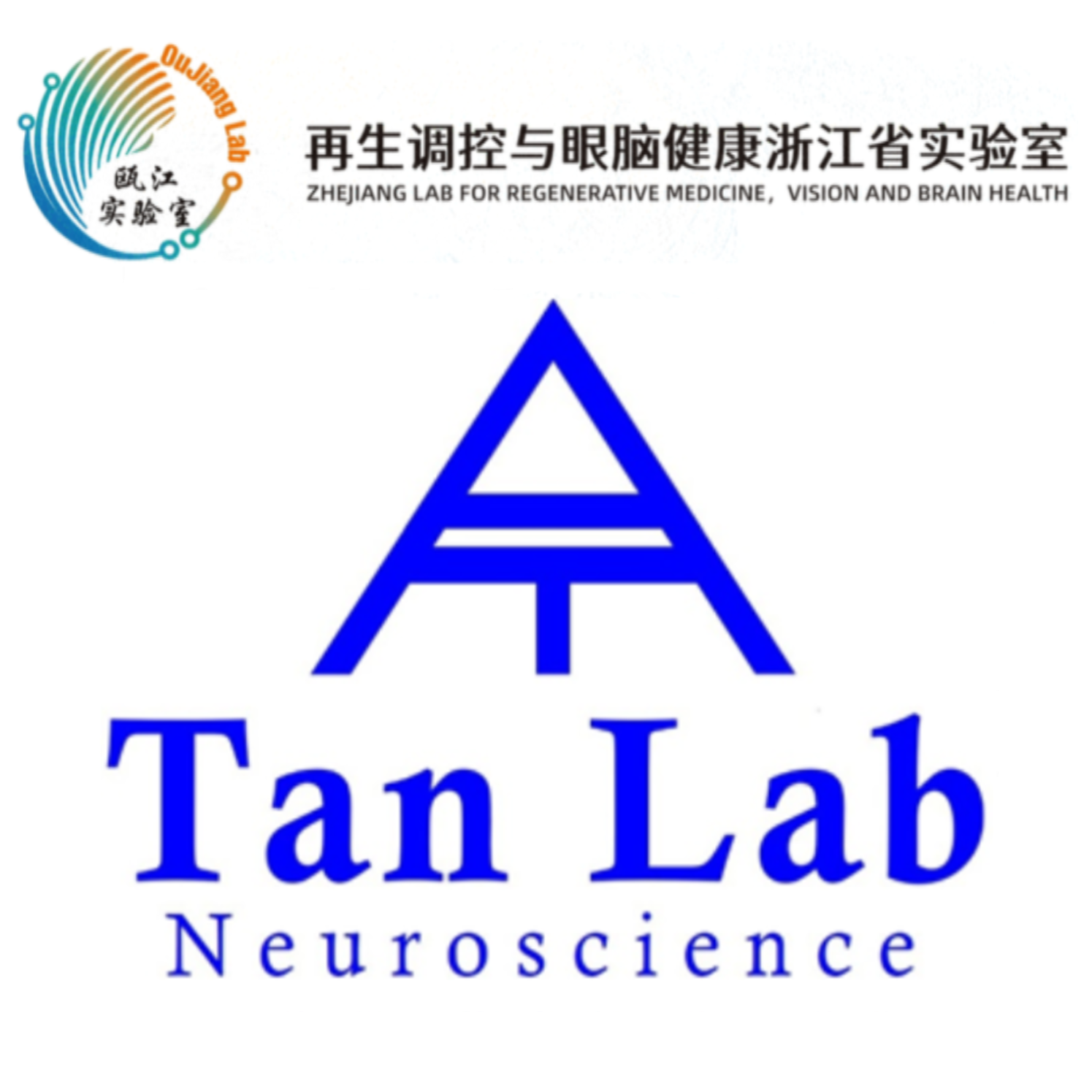
谭涛研究员 介绍
谭涛,生物医学工程博士(神经工程方向);瓯江实验室研究员、压力应激及无创神经调控课题组负责人、原贝勒医学院助理教授、温州医科大学研究生导师;
入选教育部第一批引才计划;浙江省海外高层次人才;浙江省生物医学学会睡眠研究专业委员会副主任委员、中国神经科学学会应激神经生物学分会委员、中国研究型医院学会神经再生与修复专业委员会委员、浙江省神经科学学会青年工作委员会委员、美国神经科学学会会员。
主要研究方向:1)应激性别差异的神经环路、2)眼脑解析Patch-seq多模态技术开发、3)无创磁遗传神经调控、4)神经/精神疾病神经生物学机制。
相关成果发表在Molecular Psychiatry、Biological Psychiatry、Cell Reports、Schizophrenia bulletin等学术论文43篇,其中第一/通讯(含共同)作者SCI论文20篇。独立主持课题9项(包括国自然面上/青年、温州市重大等)。任Frontiers in Behavioral Psychiatry等杂志编委,Research等SCI期刊审稿人。
Email: tantao@ojlab.ac.cn
1.主要工作经历
2023年3月至今:瓯江实验室 研究员
2021年12月-2023年3月:美国贝勒医学院 神经生物学院 助理教授
2020年7月-2021年12月:德州农工大学 医学院 研究员
2019年5月-2020年7月:纽约州立大学布法罗分校 生理与生物物理学院 研究员
2016年5月-2019年5月:纽约州立大学布法罗分校 博士后
2014年1月-2016年5月:重庆医科大学 附属儿童医院 博士后
2013年7月-2014年1月:重庆医科大学 附属儿童医院 助理研究员
2、主持的部分基金情况:
1)国家自然科学基金面上项目、青春期应激导致暴力/抑郁性别差异的BNST及环路机制研究、2025-2028
2)教育部第一批引才计划、孤独症高风险基因致病机制及无创干预研究、2024-2026
3)温州市重大科技创新攻关项目、基于整合生物学的精神分裂症精准诊疗标志物筛选与机制研究、2024-2026
4)瓯江实验室科研启动项目、孤独症高风险基因致病机制及无创干预研究、2022-2027
5)国家自然科学基金青年科学基金项目、rTMS调节AD认知功能的突触可塑性机制研究、2015-2017
6)重庆医科大学附属儿童医院杰出青年计划B类人才、rTMS调节孤独症的机制研究、2015-2016
7)中国博士后科学基金第56批面上资助“西部地区博士后人才资助计划”、rTMS调节AD认知功能的突触可塑性机制研究、2014-2016
8) 2014 年“重庆市博士后科研项目特别资助”项目、低频 rTMS 调节 AD 认知功能的突触可塑性机制研究、2014-2016
9)天津医科大学“211 工程”博士创新基金、rTMS 修复 Aβ 模型大鼠记忆损伤的机制研究、2010-2013
3、获奖
无
4、发表论文(近5年)
Google Scholar Citations: 1346; h-index: 22; i10-index: 28


通讯作者文章
1) Lin, P., Yang, J., Wu, S., Ye, T., Zhuang, W., Wang, W., & Tan, T#. (2023). Current trends of high-risk gene Cul3 in neurodevelopmental disorders. Frontiers in Psychiatry. 14.
2) Zhuang W, Ye T, Wang W, Song W, Tan T#. (2023). CTNNB1 in neurodevelopmental disorders. Frontiers in Psychiatry 14.
3) Chen H, He T, Li M, Wang C, Guo C, Wang W, Yu B, Huang J, Cui L, Guo P, Yuan Y, Tan T#. (2023) Cell-type-specific synaptic modulation of mAChR on SST and PV interneurons. Front Psychiatry. Jan 12;13:1070478.
4) Wang X, Mei D, Gou L, Zhao S, Gao C, Guo J, Luo S, Guo B, Yang Z, Wang Q, Tan T#, Zhang Y#. Functional Evaluation of a Novel GRIN2B Missense Variant Associated with Epilepsy and Intellectual Disability. Neuroscience. 2023 Aug 21;526:107-120.
5) Zhao, K., X. Zhou, M. Chen, L. Gou, D. Mei, C. Gao, S. Zhao, S. Luo, X. Wang, T. Tan# and Y. Zhang# (2023). Neuroprotective Effects of CXCR2 Antagonist SB332235 on Traumatic Brain Injury Through Suppressing NLRP3 Inflammasome. Neurochem Res.
第一/共同第一作者文章
6) Tao Tan, Wei W, Tiaotiao Liu, Ping Zh, Megan C, Xin T, Zhen Y. (2021). Neural circuits and activity dynamics underlying sex-specific effects of chronic social isolation stress. Cell Reports.
7) Tan T, Wang W, Williams J, et al. (2019). Stress Exposure in Dopamine D4 Receptor Knockout Mice Induces Schizophrenia-Like Behaviors via Disruption of GABAergic Transmission. Schizophrenia bulletin.45:1012-1023.
8) Maximiliano Rapanelli, Tao Tan, Wei Wang, et al. (2021). Behavioral, circuitry, and molecular aberrations by region-specific deficiency of the high-risk autism gene Cul3. Molecular Psychiatry
9) Tan, T., Zhang, Y., Luo, W., Lv, J., Han, C., Hamlin, J. N., ... & Song, W*. (2018). Formaldehyde induces diabetes-associated cognitive impairments. The FASEB Journal, fj-201701239R.
10) Tan, T., Wang, W., Xu, H., Huang, Z., Wang, Y. T., & Dong, Z*. (2018). Low-frequency rTMS ameliorates autistic-like behaviors in rats induced by neonatal isolation through regulating the synaptic GABA transmission. Frontiers in Cellular Neuroscience, 12, 46.
11) Ai, Li, Tao Tan, Yonghe Tang, Jun Yang, Dehua Cui, Rui Wang, Aibo Wang et al. (2019): "Endogenous formaldehyde is a memory-related molecule in mice and humans." Communications Biology 2, no. 1 1-12.
共同作者文章
12) Wang W, Xie X, Zhuang X, Huang Y, Tan T, Gangal H, Huang Z, Purvines W, Wang X, Stefanov A, Chen R, Rodriggs L, Chaiprasert A, Yu E, Vierkant V, Hook M, Huang Y, Darcq E, Wang J. Striatal μ-opioid receptor activation triggers direct-pathway GABAergic plasticity and induces negative affect. Cell Rep. 2023 Feb 7:112089.
13) Qin, Luye, Jamal B. Williams, Tao Tan, Tiaotiao Liu, Qing Cao, Kaijie Ma, and Zhen Yan. "Deficiency of autism risk factor ASH1L in prefrontal cortex induces epigenetic aberrations and seizures." Nature communications 12, no. 1 (2021): 1-14.
14) Wang W, Cao Q, Tan T, Yang F, Williams JB, Yan Z. Epigenetic treatment of behavioral and physiological deficits in a tauopathy mouse model. Aging Cell. 2021 Oct;20(10):e13456.
15) Rein B, Tan T, Yang F, Wang W, Williams J, Zhang F, Mills A, Yan Z (2021) Reversal of synaptic and behavioral deficits in a 16p11.2 duplication mouse model via restoration of the GABA synapse regulator Npas4. Mol. Psychiatry.
16) Wang, W., Rein, B., Zhang, F., Tan, T., Zhong, P., & Qin, L., et al. (2018). Chemogenetic activation of prefrontal cortex rescues synaptic and behavioral deficits in a mouse model of 16p11.2 deletion syndrome. Journal of Neuroscience, 44(6 Suppl), 99.
17) Zhu, Binglin, B Zhu, L Zhao, D Luo, D Xu, T Tan, Z Dong, Y Tang, et al. (2018). Furin promotes dendritic morphogenesis and learning and memory in transgenic mice. Cellular and Molecular Life Sciences: 1-16.
18) Wei, J., Zhong, P., Qin, L., Tan, T., & Yan, Z. (2018). Chemogenetic Restoration of the Prefrontal Cortex to Amygdala Pathway Ameliorates Stress-Induced Deficits. Cerebral Cortex, 1-11.
发表论文(>5年)
19) Shen, Y., X. Cao, T. Tan, C. Shan, Y. Wang, J. Pan, H. He and T. F. Yuan* (2016). "10-Hz Repetitive Transcranial Magnetic Stimulation of the Left Dorsolateral Prefrontal Cortex Reduces Heroin Cue Craving in Long-Term Addicts." Biol Psychiatry.
20) Huang, Z., Tan, T., Du, Y., Chen, L., Fu, M., Yu, Y., ... & Dong, Z*. (2017). Low-frequency repetitive transcranial magnetic stimulation ameliorates cognitive function and synaptic plasticity in APP23/PS45 mouse model of Alzheimer's disease. Frontiers in Aging Neuroscience, 9, 292.
21) Wei Wang, Tao Tan, Yanzhi Yu, Zhilin Huang, Yehong Du, Huili Han, Zhifang Dong*. (2017). Inhibition of AMPAR endocytosis alleviates pentobarbital-induced spatial memory deficits and synaptic depression. Behav Brain Res.
22) Guo D, Gan J, Tan T, et al. (2018) Neonatal exposure of ketamine inhibited the induction of hippocampal long-term potentiation without impairing the spatial memory of adult rats. Cognitive Neurodynamics, 1-7.
23) Wei Wang, Tao Tan, Man Tu, Wenting He, Zhifang Dong and Huili Han*. (2015). Acute Pentobarbital Treatment Impairs Spatial Learning and Memory and Hippocampal Long-Term Potentiation in Rats, Physiol Behav, 149 169-73.
24) Tao Tan, Jiacun Xie, Tiaotiao Liu, Xiaojia Chen, Xiaobo Zheng, Zhiqian Tong, Xin Tian*. (2013). Low frequency (1 Hz) repetitive transcranial magnetic stimulation (rTMS) reverses Aβ1-42 mediated memory deficit in rats. Experimental Gerontology, Volume 48, Issue 8, Pages 786-794, 2013.
25) Tao Tan, Jiacun Xie, Zhiqian Tong, Tiaotiao Liu, Xiaojia Chen, Xin Tian*(2013). Repetitive transcranial magnetic stimulation increases excitability of hippocampal CA1 pyramidal neurons. Brain Research, Volume 1520, Pages 23-35.
26) Tan, Tao, Bao-Liang Zhang and Xin Tian*. (2011). Chronic Effects of Oligomeric Abeta1-42 on Hippocampal Synaptic Plasticity in Vivo. Acta physiologica Sinica 63, no. 3: 225-32. (a)
27) Huang, X., Chen, Y. Y., Shen, Y., Cao, X., Li, A., Liu, Tao, T, Q., ... & Arias-Carrion, O*. (2017). Methamphetamine abuse impairs motor cortical plasticity and function. Molecular Psychiatry, 22(9), 1274.
28) Peng, Y., W. Wang, T. Tan, W. He, Z. Dong, Y. T. Wang and H. Han (2016). "Maternal sleep deprivation at different stages of pregnancy impairs the emotional and cognitive functions, and suppresses hippocampal long-term potentiation in the offspring rats." Mol Brain 9(1): 17.
29) Zhou, Limin; Bai, Yanjie; Li, Yanxi; Liu, Xueliang; Tan, Tao; Meng, Shasha; He, Wenting; Wu, Xiaobin; Dong, Zhifang. (2016). Overexpression of MCPH1 inhibits uncontrolled cell growth by promoting cell apoptosis and arresting the cell cycle in S and G2/M phase in lung cancer cells. Oncology Letters, 11, 1, 365-372.
30) Chen, L., W. Wang, T. Tan, H. Han and Z. Dong*. (2015). Gaba Receptors in the Central Nucleus of the Amygdala Are Involved in Pain- and Itch-Related Responses. J Pain.
31) Zhifang Dong, Huili Han, Tao Tan, Yutian Wang*, etc. (2014). Long-term potentiation decay and memory loss are mediated by AMPAR endocytosis. J Clin Invest, p. 1-14.
32) Xiaoyan Wu, Yanrui Bai, Tao Tan, Zhifang Dong*, etc. (2014). Lithium ameliorates autistic-like behaviors induced by neonatal isolation in rats. Front Behav Neurosci, 8: p. 1-12.
33) Liu, T., W. Bai, H. Yi, T. Tan, J. Wei, J. Wang and X. Tian (2014). "Functional connectivity in a rat model of Alzheimer's disease during a working memory task." Curr Alzheimer Res 11(10): 981-991.
34) Liu Aili, Li Yize, Tan Tao, Tian Xin*, (2014). Early exposure to sevoflurane inhibits Ca2+ channels activity in hippocampal CA1 pyramidal neurons of developing rats. Brain Research, 1557: p. 1-11.
35) Chen, Xiaojia; Tan, Tao; Liu, Tiaotiao; Tian, Xin. (2013). Changes of IA and IK from the pyramidal neurons at hippocampal CA1 during the early development of rats. Sheng li xue bao:[Acta physiologica Sinica], 65, 2, 193-200
36) GUO, D. Y., TAN, T., TIAN, X., & WANG, G. L. (2012). Effect of ketamine injected into cerebro ventriles on synaptic plasticity of hippocampus in adult SD rats. Journal of Tianjin Medical University, 2, 016.
37) GUO, Dong-yong; TAN, Tao; TIAN, Xin; WANG, Guo-lin. (2012). Neonatal ketamine exposure-induced cognitive dysfunction persists into adulthood in rats, Chinese Journal of Anesthesiology. 32, 4, 420-422
38) Zhang, B., Chen, X., Lin, Y., Tan, T., Yang, Z., Dayao, C., ... & Zhang, J. (2011). Impairment of synaptic plasticity in hippocampus is exacerbated by methylprednisolone in a rat model of traumatic brain injury. Brain Research, 1382, 165-172.
39) Zhang, B. L., Chen, X., Tan, T., Yang, Z., Carlos, D., Jiang, R. C., & Zhang, J. N. (2011). Traumatic brain injury impairs synaptic plasticity in hippocampus in rats. Chinese Medical Journal-Beijing, 124(5), 740.
40) Bei, Fang; Tan, Tao; Tian, Xin. (2011). Diabetes suppresses hippocampal synaptic plasticity in rats, International Journal of Biomedical Engineering. 34, 3, 150-153
41) Bei, Fang; Tan, Tao; Tian, Xin. (2010). Study on the Use of Water Maze to Test the Change of Spatial Memory Ability in Diabetic Rats, International Journal of Biomedical Engineering. 6, 321-325
